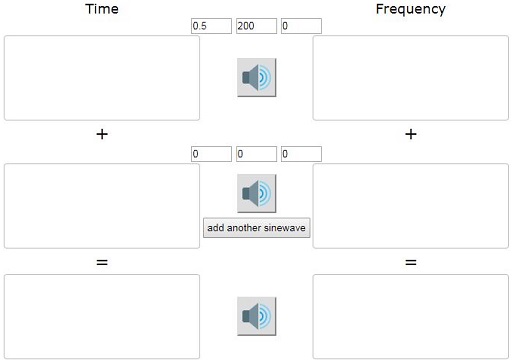4.6 From the time domain to the frequency domain
In the previous sections, you saw that complicated waveforms can be created by combining simple sine waves in a systematic way. Remarkably, any waveform can be represented as a combination of sine waves of appropriately chosen amplitude (loudness), frequency (pitch) and phase. This result, demonstrated by the French mathematician and physicist Joseph Fourier (1768–1830), lies at the heart of the design of electronic systems to reproduce high-fidelity sound.
The most familiar representation of waves is in what is called the time domain, i.e. the changing value of the signal through time. As you have seen, complicated waves can be formed from combinations of sine waves of given frequency and amplitude. This allows another representation in what is called the frequency domain. To see this, enter the following waves into Interactive 4:
- Wave 1: A = 0.7, f = 110 Hz
- Wave 2: A = 0.2, f = 330 Hz
- Wave 3: A = 0.1, f = 550 Hz
- Wave 4: A = 0.05, f = 770 Hz.
SAQ 12
- a.What is the shape of the combined waveform?
- b.What do you see to the right of the combined waves, in the ‘frequency domain’?
Answer
- a.The shape approximates a square wave, as shown in the previous section.
- b.Read the following.
Figure 30 shows the composite wave formed from the four sine waves listed above. On the right of this is a graph showing amplitude against frequency. There is a vertical line of height A = 0.7 corresponding to frequency f = 110 Hz, a vertical line of height A = 0.2 corresponding to f = 330 Hz, a vertical line of height A = 0.1 corresponding to f = 550 Hz and a vertical line of length A = 0.05 corresponding to f = 770 Hz. This set of lines is called the frequency spectrum of the signal on the left.
One of the many problems with reproducing sound is that the desired sound may be contaminated by noise. For example, if you record a video and commentary on your phone in a crowded place, you will record what you want (you speaking) but also what you may not want (the hubbub surrounding you). Engineers talk about the part of the recording that is wanted as the signal and the part that is not wanted as noise.
For example, suppose you are recording yourself playing the piano and an emergency vehicle goes past with its high-pitched siren blaring. By using electronics, it may be possible to filter out that unwanted noise, or at least make it a lot less intrusive.
To represent noise, add a fifth sine wave to your signal with A = 0.3 and f = 935 Hz. This distorts the signal, as shown in Figure 31. Click on the loudspeaker button and you will hear that the sound is now quite discordant. It is not very clear what the noise is doing in the time-domain representation on the left, but the rogue frequency of 935 Hz can be seen clearly as a vertical bar of length 0.3 in the frequency-domain representation on the right. Now it is easy to imagine that one could take a pair of scissors and snip out that unwanted part of the composite signal in the frequency domain, before reassembling everything as the ‘cleaned’ signal in the time domain.
Apart from removing unwanted noise, Fourier’s theory can also be used to manipulate signals in the frequency domain to give interesting new aesthetic results when the signals in the time domain are played through a loudspeaker. This has stimulated research and technology that has been widely used in the music industry for more than half a century, since the invention of the electric guitar.



